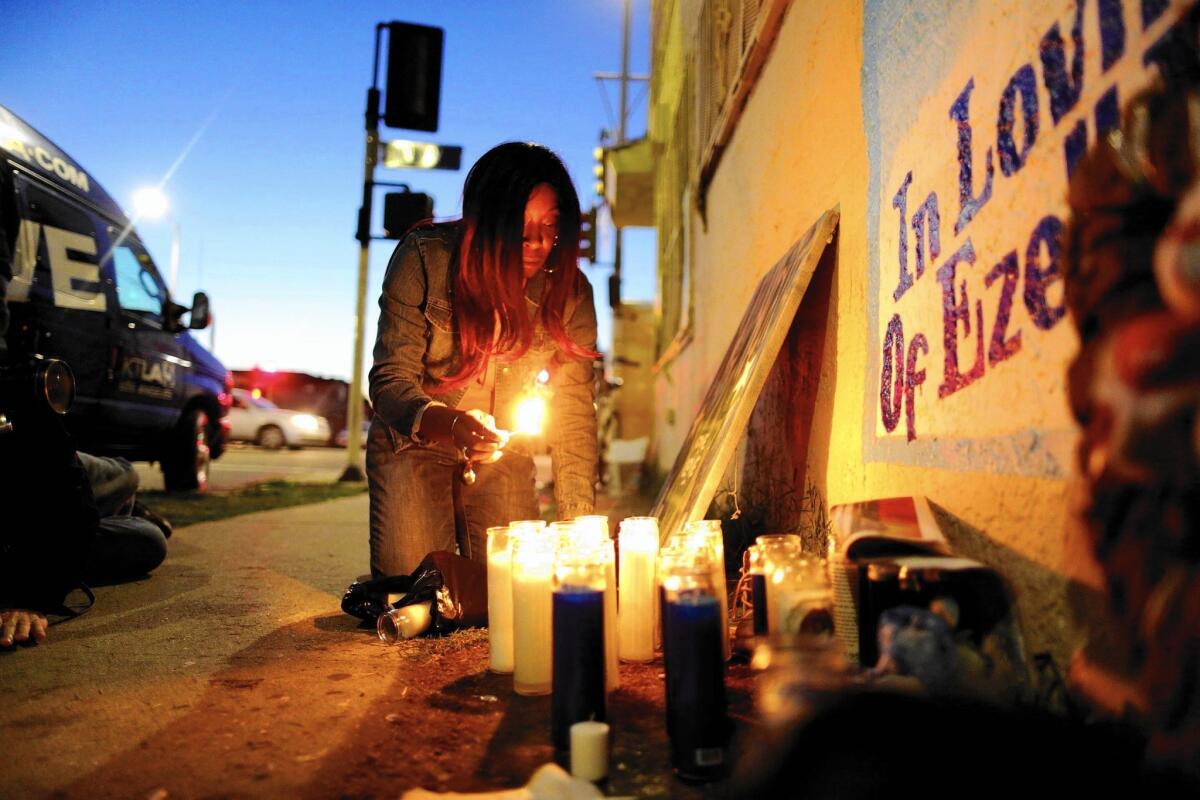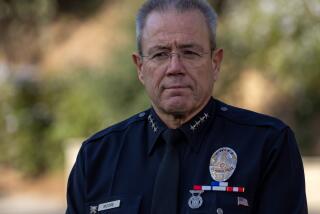Ezell Ford autopsy, LAPD chief disclose new details of shooting

A South Los Angeles man who was killed in a police shooting in August was shot in the back at close range during what LAPD Chief Charlie Beck described Monday as a violent struggle over an officer’s gun.
The new details about the shooting came as an autopsy report released Monday showed that Ezell Ford was struck three times, including once so closely in the back that the muzzle of the officer’s gun left an imprint.
Ford, 25, who was mentally ill, was also shot in the right side and right arm, according to the autopsy report, which had been withheld by the LAPD for months after the shooting.
At a news conference Monday, Beck offered a narrative of the incident based on the two police officers’ accounts. He cautioned that the picture was incomplete because the internal investigation would take several more months, and no eyewitnesses have spoken to police.
According to Beck, Ford forced a police officer to the ground and grabbed the officer’s gun. The officer yelled to his partner that his gun had been taken, Beck said, and the partner fired two rounds at Ford. The first officer used a backup weapon to reach around Ford’s body and shoot him in the back.
Beck seconded policing experts who said that autopsy reports are of limited value by themselves. But he also said the report did not contradict the officers’ statements that one of them was wrestling with Ford for his handgun.
“I believe in my Police Department, but I also believe we’re as good as we can be because we carefully scrutinize everything we do,” Beck said. “We will find out what happened on that August night.”
The report’s release comes after a wave of nationwide protests over several recent deaths of unarmed black men at the hands of police, including Michael Brown in Ferguson, Mo., and Eric Garner in New York.
On Monday, people gathered in Leimert Park and in front of LAPD headquarters invoked those deaths while zeroing in on the disclosure that Ford, who was also black, was shot in the back.
“That does not bode well for the LAPD,” said Jeff Page, 49, a skid row community organizer. “He wasn’t even facing them when that shot was fired.”
Steven Lerman, an attorney for the Ford family, said the autopsy report shows that the shooting was unjustifiable, strengthening the family’s civil lawsuit against the Police Department and the city.
Ford’s mother, Tritobia Ford, was overwhelmed with tears and anger when they went over the report together, Lerman said.
“Anything he says is self-serving,” Lerman said of Beck. “What the report shows is that Ezell was shot in the back and killed.”
But experts on police shootings said the fact that Ford was shot in the back does not necessarily mean the officers acted improperly.
Ed Obayashi, an Inyo County sheriff’s deputy who is also an attorney and an expert on police use of force, said that while some people may be troubled by the fact that Ford was shot in the back, “That’s not unusual. It happens all the time.”
On Monday evening, Ford’s mother, her hand shaking, lit candles at a mural bearing her son’s likeness near where he had been shot.
She declined to comment, but Ford’s parents have previously said that their son was diagnosed with depression, schizophrenia and bipolar disorder. He went from a social boy who dreamed of being a basketball star to a withdrawn young man who was known for cadging cigarettes and wandering his neighborhood. He once walked to Long Beach for no apparent reason, his parents said.
According to Los Angeles County court records, Ford had convictions for marijuana possession and illegally possessing a loaded firearm. The autopsy report showed some marijuana in his system but no other drugs.
Ford was a familiar figure in the neighborhood, but Beck said the officers did not know him and did not know he was mentally ill.
In the days after Ford’s death, a friend of his family told The Times that she witnessed part of the encounter and saw no struggle between Ford and the officers. Dorene Henderson said she heard someone yell, “Get down! Get down!” One officer was outside of the patrol car when she heard a gunshot, she said.
“They had the bright light on him and they told him to get down and he just kept walking, and that’s when they shot him the first time,” Henderson said.
Seconds later, she said, she saw a second officer get out of the driver’s side of the police vehicle. “That’s when everyone kept hollering that he had mental problems, and they shot him two more times,” Henderson said.
Another unidentified man told KTLA-TV Channel 5 that Ford was shot in the back while lying down, an account that contributed to a backlash on social media against the LAPD following the shooting.
The LAPD has identified the two officers as Sharlton Wampler, a 12-year veteran who is Asian American, and Antonio Villegas, an eight-year veteran who is Latino. Both were with the Newton Division gang enforcement detail and have been reassigned to administrative duty.
Larry Hanna, the officers’ attorney, declined to discuss the details of the case but said he was confident that once the full report comes out, “there will be no wrongdoing by these officers.”
The Police Department delayed making the autopsy report public, arguing that doing so could influence the stories of any witnesses to Ford’s shooting. But Mayor Eric Garcetti set a deadline of the end of the year for the report’s release.
“I ordered the autopsy’s release because transparency is key to the trust between the LAPD and the people they serve,” Garcetti said in a statement Monday.
About 8:10 p.m. on Aug. 11, Ford was walking on West 65th Street near Broadway when the two officers got out of their car to speak with him, according to the LAPD’s account. He looked at the officers, walked away and attempted to conceal his hands.
The officers followed Ford to a driveway, where he crouched between a car and a row of bushes, Beck said. As one of the officers reached for him, Ford grabbed the officer and the struggle for the officer’s gun began.
Beck said the muzzle imprint on Ford’s back was consistent with the backup weapon used by the officer. Beck did not provide a detailed reason for the initial stop, saying only that Ford was acting suspiciously. The decision to stop Ford will be vetted as part of the investigation, Beck said.
Greg Meyer, a retired LAPD captain and use of force expert, cautioned that the Ford autopsy is only one piece of the overall investigation.
“It does not answer the questions that people are most interested in: Why a person was stopped and what happened after that?” Meyer said.
Questions that are likely to persist are why the officers stopped Ford and what information they had — if any — about his mental illness, Obayashi, the Inyo County sheriff’s deputy, said. He cited a recent court ruling that requires police to consider a suspect’s mental state if they are aware of such problems.
Sid Heal, a retired Los Angeles County Sheriff’s Department commander who once oversaw the SWAT unit and has testified in numerous court cases about police force, said the use of a backup weapon shows that the officer was desperate and believed he was in a life-or-death struggle.
“It’s almost never a first choice to use a backup gun,” Heal said. “They’re smaller and less accurate and basically designed to save your own life.”
But Cliff Smith, a member of the South-Central Neighborhood Council who pushed for the autopsy’s release, said many South Los Angeles residents are skeptical of the police version of events.
“Somebody put a gun to his back and pulled the trigger,” Smith said. “There’s just no conceivable, rational, justifiable explanation for that.”
Smith said the community is still waiting for answers in the death of another man, Omar Abrego, who died after a physical confrontation with LAPD officers in South Los Angeles days before Ford’s death. The LAPD has also placed a security hold on Abrego’s autopsy.
Times staff writers Tre’vell Anderson, Scott Glover, Angel Jennings, Samantha Masunaga, Brittny Mejia, Garrett Therolf and Ruben Vives contributed to this story.
More to Read
Sign up for Essential California
The most important California stories and recommendations in your inbox every morning.
You may occasionally receive promotional content from the Los Angeles Times.













